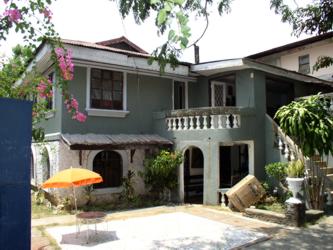|
(Photo album) |
Español
|
|
(Photo album) |
Español
|
 Abra
in the Philippines connotes a remote, wild, backward and undeveloped place,
and in purely economic terms maybe it is. But nobody would suspect that
in a town called Tayum (how many have heard the name of this town in the
Philippines?) with no more than 12,000 souls there would be three museums.
My interest is centered in that existing in and around the house of Ex
Amb. Rosario “Saring”Cariño. Abra
in the Philippines connotes a remote, wild, backward and undeveloped place,
and in purely economic terms maybe it is. But nobody would suspect that
in a town called Tayum (how many have heard the name of this town in the
Philippines?) with no more than 12,000 souls there would be three museums.
My interest is centered in that existing in and around the house of Ex
Amb. Rosario “Saring”Cariño.
A cousin of my mother-in-law, Saring Cariño belongs to the family of the first Galician who arrived in Candon in late 17th century, Ignacio Cariño. Gabriela Silang, the noted Ilokano revolutionary of the 18th century, was a daughter of Ignacio’s eldest son Anselmo and a Tingian house servant in the Cariño household in Candon. When her husband was executed, she fled to Abra and took refuge in Tayum, in the house of her uncle Nicolas, Anselmo’s brother. Saring is a direct descendant of Nicolas and their ancestral home is home also today to the Cariño museum. Maintained with loving care by Saring one can visit the room occupied by Gabriela when she lived there. Through his professional life, Cariño amassed a fantastic wealth of artworks, furniture, artifacts, documents and books. He built near his ancestral home a building, almost a warehouse, some 50 m in length where he maintains an office and collections. Today, he is retired living a very simple life dedicated to maintaining his collections, a Herculean task because he receives no help, private or public. Most valuable in his collection is perhaps a Picasso, a Juan Luna, a Ghirlandaio and several XIX originals. But the museum also features fabulous Chinese and Japanese porcelain collections, Burmese bronzes, local church antique sculptures and pieces and other valuable artifacts. He has also a most interesting “Map Room” with copies of the first geodetic maps of the Northern Cordillera made by first Abra Governor Captain Ramon Tajonera in the 1840s and an alternate map of the town of Bucay, with projects for the incipient town. Bucay, however, was built according to a different map, also by Tajonera, approved by the central government in Manila. In his files is also the report of one of the expeditions from Abra to Cagayan Valley led by same Governor Tajonera. The other two museums in Tayum are the Catholic Church Museum with treasures accumulated through centuries and that in the house of the Brillantes family. It would be so desirable that the three museums one day, before the treasures begin to dissipate or decay, would be under a single roof. The town then would become a very important cultural reference in Northern Luzon. |
| If you don't see the menu at left,
click on our |
Jose R. Perdigon; July 2007
Mail comments to perdigon@globelines.com.ph |